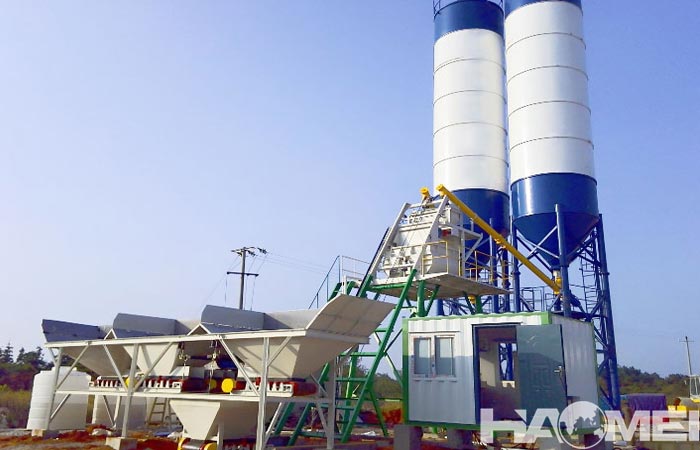A Concrete Batch Mix Plant - HZS50
Writer:Admin Time:25/10/30A concrete batch mix plant is a large-scale mechanical equipment integrating material storage, metering, mixing, and transportation. It is mainly used for centralized concrete production and is widely applied in construction, bridge, and road engineering. Its core function is to precisely mix raw materials such as cement, sand and gravel aggregates, water, and admixtures according to a preset ratio through an automated control system to produce concrete that meets engineering requirements.

A typical concrete batch mix plant consists of a batching machine, a mixing host, powder silos, a conveying system, a metering system, and an electrical control system, featuring high production efficiency, stable quality, and easy operation. Taking the HZS50 concrete batching plant as an example:
The HZS50 is a medium-sized concrete mixing equipment with a theoretical production rate of 50 cubic meters per hour, suitable for small and medium-sized construction projects, precast component plants, and commercial concrete production. Its core configuration includes:
1. Mixing host:
Adopting a JS1000 twin-shaft forced concrete mixer with a mixing power of 37kW and a discharge volume of 1 cubic meter. This host achieves efficient mixing through wear-resistant alloy liners and optimized fluid design, ensuring the homogeneity of the concrete meets standards while extending the equipment's service life.
2. Batching System:
Standard configuration includes a PLD1600 four-bin batching machine with a total aggregate bin volume of 13 cubic meters, capable of simultaneously processing four different aggregate sizes (≤80mm). Metering accuracy is ±2% for aggregates, ±1% for cement, ±1% for water, and ±1% for admixtures. Pressure sensors and pneumatic control technology ensure precise batching.
3. Conveying and Storage:
A screw conveyor handles powder transportation with a capacity of 40 tons/hour; the belt conveyor uses a herringbone design with a conveying capacity of 300 tons/hour, ensuring continuous material supply. The cement silo capacity is typically 100 tons and can be expanded as needed.
4. Control System:
Equipped with a three-in-one intelligent system integrating microcomputer control, LCD display terminal, and PC, supporting automatic batching, fault diagnosis, data storage, and printing functions.
Core advantages of HZS50 concrete batch mix plant:
1. High cost-effectiveness and flexibility
The HZS50's equipment cost is approximately 1/3 to 1/2 that of a large-scale concrete batching plant, and it only requires about 200 square meters of space, making it particularly suitable for projects with limited budgets or site constraints. For example, a Philippine customer introduced the HZS50 and quickly completed installation through its modular design for producing precast concrete components. Its automatic batching system and pulse dust removal equipment not only improved production efficiency but also met environmental protection requirements, saving approximately 15% of cement consumption per month.
2. Highly efficient and stable production capacity
Through the forced mixing of the twin-shaft mixer and the precise metering system, this equipment can stably produce concrete with strength grades from C10 to C60. In the Baukao irrigation project in East Timor, the HZS50 concrete batch plant operates continuously for 10 hours a day, providing high-quality concrete for dams and irrigation canals. Its one-button start function and bagged cement unloading design (adapting to local transportation conditions) significantly improved construction efficiency.
3. Outstanding intelligent and environmental performance
The HZS50's electronic control system supports formula storage, automatic error correction, and remote monitoring, reducing human intervention. For example, a project in Indonesia used the HZS50 to supply concrete for bridge construction, achieving a 20% increase in annual production capacity and a 15% reduction in labor costs through intelligent management. In terms of environmental protection, pulse-jet dust collectors and wastewater recycling systems (such as pressurized drainage technology) reduce dust emissions to below 10mg/m³, and achieve a 70% water recycling rate, meeting national green construction standards.
4. Rapid deployment and adaptability
Some models (such as mobile concrete batching plant YHZS50) feature a wheeled structure and integrated design, allowing for direct towing and relocation by tractor units, enabling disassembly, transportation, and reinstallation within 24 hours. In the Manggor-Kagaguga Bridge project in Papua New Guinea, this equipment, with its rapid deployment capability, provided timely concrete supply for the construction of 17 bridges, saving the installation time compared to traditional batching plants.
The HZS50 concrete batch mix plant, with its moderate capacity, accurate metering, flexible configuration, and high cost-effectiveness, has become an ideal choice for small and medium-sized projects. Whether for domestic precast component production or overseas infrastructure construction, the HZS50 concrete batching plant delivers significant economic benefits to customers through stable performance and intelligent management. Its modular design, environmentally friendly technology, and rapid response capabilities also give it a competitive edge in the industry's green transformation.

